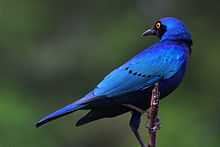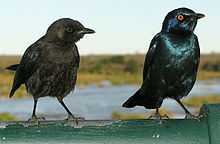Greater blue-eared starling
| Greater blue-eared starling | |
|---|---|
 | |
| Adult in Kruger National Park | |
| Conservation status | |
| Scientific classification | |
| Kingdom: | Animalia |
| Phylum: | Chordata |
| Class: | Aves |
| Order: | Passeriformes |
| Family: | Sturnidae |
| Genus: | Lamprotornis |
| Species: | L. chalybaeus |
| Binomial name | |
| Lamprotornis chalybaeus (Hemprich & Ehrenberg, 1828) | |
The greater blue-eared starling or greater blue-eared glossy-starling (Lamprotornis chalybaeus) is a bird that breeds from Senegal east to Ethiopia and south through eastern Africa to northeastern South Africa and Angola. It is a very common species of open woodland bird, and undertakes some seasonal migration.
Description
_looking_right_from_behind.jpg)
The greater blue-eared starling is a 22-cm long, short tailed bird. This starling is glossy blue-green with a purple-blue belly and blue ear patch. Its iris is bright yellow or orange. The sexes are similar, but the juvenile is duller and has blackish brown underparts.
The populations from southern Kenya southwards are smaller than northern birds and are sometimes considered to be a separate subspecies, L. c. sycobius.
The lesser blue-eared starling is similar to this species, but the blue of the belly does not extend forward of the legs.
The greater blue-eared starling has a range of musical or grating calls, but the most familiar is a nasal squee-ar.
Behaviour
Breeding

The greater blue-eared starling nests in holes in trees, either natural or excavated by woodpeckers or barbets. It will also nest inside the large stick nests of the sacred ibis or Abdim's stork. A nest will include three to five eggs, which are usually greenish-blue with brown or purple spots, and hatch in 13–14 days. The chicks leave the nest roughly 23 days after hatching.
This species is parasitised by the great spotted cuckoo and occasionally by the greater honeyguide.
Roosting
The greater blue-eared starling is highly gregarious and will form large flocks, often with other starlings. Its roosts, in reedbed, thorn bushes, or acacia, may also be shared.
Feeding
Like other starlings, the greater blue-eared starling is an omnivore, taking a wide range of invertebrates seeds and berries, especially figs, but is diet is mainly insects taken from the ground.
It will perch on livestock, feeding on insects disturbed by the animals and occasionally removing ectoparasites.
References
- ↑ BirdLife International (2012). "Lamprotornis chalybaeus". IUCN Red List of Threatened Species. Version 2013.2. International Union for Conservation of Nature. Retrieved 26 November 2013.
- Feare, Chris; Craig, Adrian (1999). Starlings and Mynas. Princeton University Press. ISBN 0-7136-3961-X.
- Sinclair, Ian; Hockey, Phil and Tarboton, Warwick (2002). SASOL Birds of Southern Africa. Struik. ISBN 1-86872-721-1.
External links
| Wikimedia Commons has media related to Lamprotornis chalybaeus. |
- Greater blue-eared starling - Species text in The Atlas of Southern African Birds
